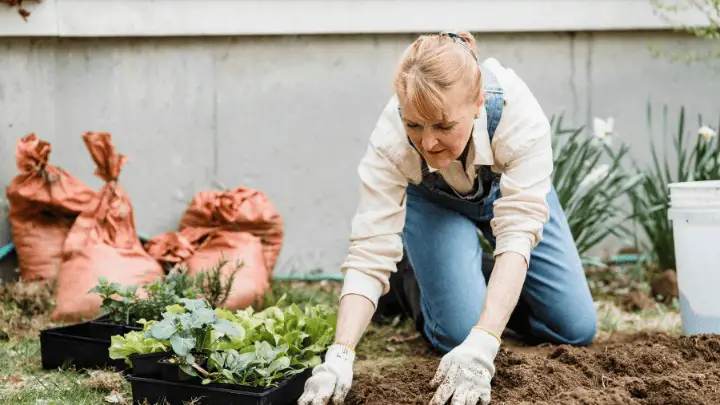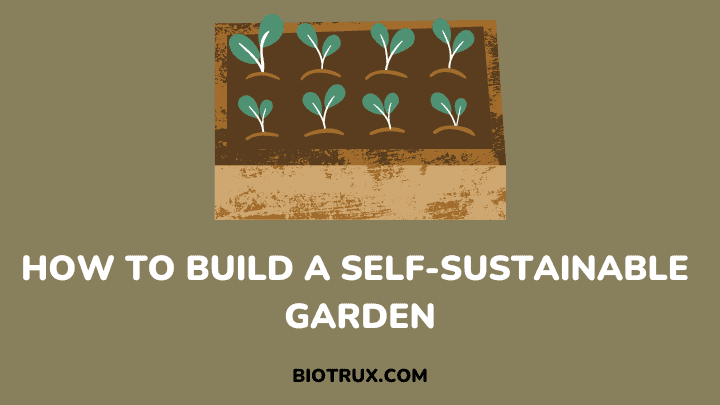Are you tired of relying on the grocery store for fresh produce? Interested in living a more sustainable lifestyle? It’s time to build a self-sustainable garden. It will provide fresh fruits and vegetables, promote self-sufficiency, and reduce your carbon footprint.
However, building a self-sustainable garden can seem daunting at first glance. But fear not; with a little knowledge and dedication, anyone can create a thriving garden that sustains itself year-round.
From choosing the right crops to water conservation techniques, this guide will outline all the steps necessary to build a successful self-sustainable garden. So, get ready to dive into sustainable gardening and discover the joy of growing your food.
How to Build a Self-Sustainable Garden: Getting Started

1. Understand why you want to build a self-sustainable garden
Building a self-sustainable garden may seem daunting, but it’s an achievable goal to help you save money while providing fresh produce. However, before you start, it’s important to understand why you want to build a self-sustainable garden.
Understanding your goals and motivations for building a self-sustainable garden can help you create a plan that works for you. For instance, you might focus on growing fruits and vegetables to reduce your grocery bill and eat healthier.
On the other hand, if you want to reduce your carbon footprint, you might focus on planting trees, herbs, and flowers that attract bees and butterflies. Once you have a clear idea of your goals, you can start planning your garden.
2. Choosing the ideal location
The next step in creating a self-sustainable garden is selecting the ideal location. Look for an area in your yard that receives ample sunlight throughout the day.
Most vegetables and herbs require at least six hours of direct sunlight to flourish. Ensure that the soil in the chosen spot is fertile and well-draining to support healthy plant growth.
3. Preparing the soil
Properly preparing the soil is crucial to provide a nutrient-rich foundation for your plants. Begin by removing any weeds or unwanted vegetation from the area.
Loosen the soil using a garden fork or tiller to improve its structure and aeration. Incorporate organic matter, such as compost or well-rotted manure, to enhance the soil’s fertility. Remember, healthy soil is the key to a thriving self-sustainable garden.
4. Choosing the right plants
When it comes to selecting plants for your self-sustainable garden, opt for varieties that are well-suited to your climate and growing conditions.
Consider planting a mix of vegetables, fruits, herbs, and flowers to create a diverse and balanced ecosystem. Companion planting involves growing compatible plants together, which can help deter pests and improve overall garden health.
Sustainable Gardening Practices for a Self-Sustainable Garden
1. Implement a composting system
To start a composting system, you’ll need a designated area to store your compost. You can purchase a compost bin or create your own using materials like chicken wire or pallets. Once you have your compost bin, start collecting organic waste such as fruit and vegetable scraps, eggshells, and yard waste like leaves and grass clippings.
You should add a balance of greens (food scraps, grass clippings, and other nitrogen-rich materials) and browns (leaves and paper, which are higher in carbon). Keep your compost moist and turn it in every few weeks to aerate the material and help it break down faster.
Over time, your compost will transform into a dark, crumbly material perfect for fertilizing your garden. Spread a layer of compost around the base of your plants or work it into the soil before planting. This will give your garden a natural boost.
A composting system in your garden reduces your environmental impact, saves money on fertilizers, and creates a healthier, more self-sustainable garden. Give it a try and see the difference it makes.
2. Incorporate water conservation techniques
Here are a few tips on how to incorporate water conservation techniques in your garden:
- Collect rainwater: One of the easiest ways to reduce water usage is to collect rainwater. You can place a rain barrel or a similar collection system beneath your downspouts to collect the runoff from your roof. This water can water your garden instead of relying on municipal water supplies.
- Use mulch: Mulching your garden can help retain moisture in the soil, reducing the amount of water you need. A layer of mulch over the soil can help to prevent water evaporation, keep the soil cool, and suppress weeds.
- Plant drought-tolerant varieties: Choosing plants suited to your local climate can help reduce your water usage. Drought-tolerant plants are a great option for regions that experience long periods of dry weather.
- Use drip irrigation: Drip irrigation systems are a more efficient way to water your plants. Instead of spraying water over the entire garden, drip irrigation delivers water directly to the roots of each plant.
These conservation techniques can reduce water usage while growing a lush, productive garden. A self-sustainable garden not only benefits the environment, but it can also save you money on water bills in the long run.
3. Organic pest control
One of the best ways to keep pests away from your garden is to attract beneficial insects. Ladybugs, lacewings, and praying mantises are beneficial insects that can help control pests like aphids and caterpillars.
Planting flowers like marigolds and calendulas can attract these helpful bugs to your garden. Another organic pest control method is to practice crop rotation. This involves alternating the plants in your garden to prevent pests from becoming too comfortable in one area.
For example, if you grow tomatoes in one area one year, plant something else, like beans or peas, in that spot the following year. Handpicking pests is another effective way to control their populations.
This may not be feasible for large gardens, but it’s a simple and effective solution for smaller ones. Keep an eye out for pests like caterpillars, snails, and slugs, and remove them by hand.
Lastly, natural pest control products such as neem oil, garlic spray, and diatomaceous earth are available. These products work by either repelling or killing pests without harming beneficial insects.
4. Optimize the growing season
If you want to build a self-sustainable garden, one of the key practices you should adopt is optimizing the growing season. This means ensuring your plants have the best possible growing conditions and taking advantage of the natural rhythms of the seasons.
To start, choose plants well-suited to your local climate and soil type. This will help them thrive without requiring many extra resources or interventions. Then, pay attention to the timing of your plantings.
Planting at the right time can help ensure your crops mature before extreme weather conditions like frost or heatwaves. Another way to optimize the growing season is by using crop rotation and companion planting techniques.
These practices help improve soil health and can even increase yields by promoting biodiversity in your garden. You can also use season-extending techniques like cold frames or greenhouses to extend the growing season.
This allows you to start planting earlier in the year, and to keep your plants going well into the fall or even winter months.
5. Limit the use of herbicides and pesticides
When building a self-sustainable garden, it’s important to practice sustainable gardening. One such practice is to limit the use of herbicides and pesticides. Herbicides and pesticides are chemicals used to kill unwanted weeds and pests in the garden.
However, they can also harm beneficial insects and pollinators essential for a healthy garden ecosystem. Limiting herbicides and pesticides can promote a more natural balance of pests and predators in your garden.
This can reduce the need for these chemicals and ultimately promote a healthier, more sustainable garden.
6. Learn to store or preserve seeds
One of the key elements of a self-sustainable garden is the ability to collect and store your seeds. In addition to saving money, your garden can maintain a healthy and diverse ecosystem. Storing and preserving seeds is a simple practice that any gardener can adopt.
The first step is to collect seeds from your strongest and healthiest plants. Once you have collected your seeds, they should be allowed to dry out fully in a cool, dark, and dry space. After your seeds are fully dried, you can store them in an airtight container.
Be sure to label each container with the type of seed and the date it was collected. Store your seed containers in a cool, dark, and dry location to ensure their viability for future planting. Preserving your seeds allows you to maintain your garden’s health and helps maintain genetic diversity in your plants.
By collecting and planting your seeds, you are allowing natural selection to take place in your garden. Over time, this can lead to stronger and more resilient plants better suited to your unique climate and soil conditions.
FAQs
What are the benefits of building a self-sustainable garden?
Building a self-sustainable garden offers numerous benefits. It allows you to grow your organic produce, reduces your carbon footprint, promotes biodiversity, and enhances your overall well-being through the joy of gardening.
Do you need any special tools or equipment for a self-sustainable garden?
While basic gardening tools like a shovel, rake, and watering can are essential, you don’t need any special equipment for a self-sustainable garden. Focus on using sustainable practices rather than relying on high-tech gadgets.
Can you build a self-sustainable garden in a limited space like a balcony or rooftop?
Yes. Self-sustainable gardens can be created in small spaces like balconies, rooftops, or vertical gardens. Use containers, vertical planters, and hanging baskets to maximize your space.
How long does it take to build a self-sustainable garden?
The time required to build a self-sustainable garden can vary based on factors such as garden size, preparation, and plant growth rates. It is an ongoing process that requires patience and continuous effort.
Are there any specific plants that are ideal for a self-sustainable garden?
Various plants are well-suited for self-sustainable gardens. Some popular choices include tomatoes, peppers, lettuce, herbs like basil and mint, and fruits like strawberries. Research the specific requirements of each plant to ensure successful cultivation.
Final Thoughts
In conclusion, building a self-sustainable garden requires effort and dedication, but you can have a beautiful and productive garden that benefits you and the environment.
Following the tips and techniques discussed in this article, you can create a garden that requires minimal maintenance.
It provides fresh fruits, vegetables, and herbs all year round, reduces greenhouse gas emissions, conserves water, and supports biodiversity.
Remember to involve your community by sharing your knowledge and resources and encouraging others to start their self-sustainable gardens.
With a self-sustainable garden, you’ll enjoy the benefits of a healthier lifestyle, save money, and contribute to a more sustainable future for generations. Happy gardening!
If you work from home and are an environment enthusiast, I recommend you learn how to create a sustainable home office.
Thanks for reading.

